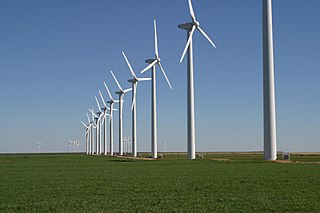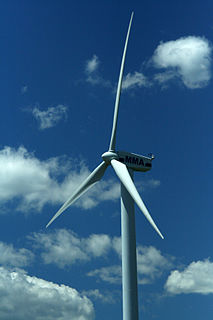
A wind farm or wind park, also called a wind power station or wind power plant, is a group of wind turbines in the same location used to produce electricity. Wind farms vary in size from a small number of turbines to several hundred wind turbines covering an extensive area. Wind farms can be either onshore or offshore.

The United Kingdom is one of the best locations for wind power in the world and is considered to be the best in Europe. Wind power contributed 18% of UK electricity generation in 2018, making up 52% of electricity generation from renewable sources. Wind power in the UK is a popular low cost generation mode which is still dropping in price and delivers a rapidly growing percentage of the electricity of the United Kingdom.
Interreg is a series of programmes to stimulate cooperation between regions in and out of the European Union (EU), funded by the European Regional Development Fund. The first Interreg started in 1989. Interreg IV covered the period 2007–2013. Interreg V (2014-2020) covers all 27 EU member states, the EFTA countries, six accession countries and 18 neighbouring countries. It has a budget of EUR 10.1 billion, which represents 2.8% of the total of the European Cohesion Policy budget. Since the non EU countries don't pay EU membership fee, they contribute directly to Interreg, not through ERDF.

Wind power in Germany is a growing industry. The installed capacity was 55.6 gigawatt (GW) at the end of 2017, with 5.2 GW from offshore installations. In 2019, a quarter of the country's total electricity was generated using wind power, compared to an estimated 9.3% in 2010.

As of December 2017, installed capacity of wind power in the European Union totaled 169.3 gigawatts (GW). In 2017, a total of 15,680 MW of wind power was installed, representing 55% of all new power capacity, and the wind power generated 336 TWh of electricity, enough to supply 11.6% of the EU's electricity consumption.

Wind power in the United States is a branch of the energy industry that has expanded quickly over the latest several years. From January through December of 2019, 300.1 terawatt-hours were generated by wind power, or 7.29% of all generated electrical energy in the United States.

Wind power generation capacity in India has significantly increased in recent years. As of 29 February 2020 the total installed wind power capacity was 37.669 GW, the fourth largest installed wind power capacity in the world. Wind power capacity is mainly spread across the Southern, Western and Northern regions.

Wind power in Scotland is the fastest-growing renewable energy technology, with 8423 MW of installed wind power capacity as of December 2018. This included 7800 MW from onshore wind in Scotland and 623 MW of offshore wind generators.

Renewable energy in the United Kingdom can be divided into production for electricity, heat, and transport.

A floating wind turbine is an offshore wind turbine mounted on a floating structure that allows the turbine to generate electricity in water depths where fixed-foundation turbines are not feasible. Floating wind farms have the potential to significantly increase the sea area available for offshore wind farms, especially in countries with limited shallow waters, such as Japan. Locating wind farms further offshore can also reduce visual pollution, provide better accommodation for fishing and shipping lanes, and reach stronger and more consistent winds.

Offshore wind power or offshore wind energy is the use of wind farms constructed in bodies of water, usually in the ocean, to harvest wind energy to generate electricity. Higher wind speeds are available offshore compared to on land, so offshore wind power’s electricity generation is higher per amount of capacity installed, and NIMBY opposition to construction is usually much weaker.

Wind power in Belgium depends partially on regional governments and partially on the Belgian federal government. Wind energy producers in both the Flemish and Walloon regions get green certificates but not with the same conditions.
The North Sea Offshore Grid, officially the North Seas Countries Offshore Grid Initiative (NSCOGI), was a collaboration between EU member-states and Norway to create an integrated offshore energy grid which links wind farms and other renewable energy sources across the northern seas of Europe. It is one of several proposed European super grid schemes. Since 2016, the cooperation has been integrated into the new Political Declaration on energy cooperation between the North Seas Countries.
The ISLES was a project to facilitate the development of offshore renewable energy sources, such as wind, wave and tidal energy, and renewable energy trade between Scotland, Republic of Ireland and Northern Ireland. It assessed the feasibility and developed a conception of creating an integrated offshore transmission network connecting the renewable energy projects' sites located off the west coast of Scotland, north and east coasts of Northern Ireland, west coast of the Republic of Ireland and in the Irish Sea with onshore grids. It was a joint project between the governments of Scotland, Ireland, and Northern Ireland, which is partly funded by the European Union's INTERREG IVA Programme. The funding from INTEREG was about €2 million.

The U.S. state of Massachusetts has vast wind energy resources onshore as well as offshore and the installed capacity has been growing in recent years due to a variety of regulatory actions and financial incentives enacted by the state government. The most recent notable policy includes the 2016 update to the Clean Energy and Climate Plan that the state reduce 1990 baseline greenhouse gas emissions levels by 25% by 2020, and a goal of installing 2,000 MW of wind power in the state by 2020. However in 2016 the state had 119 megawatts (MW) of wind powered electricity generating capacity, responsible for generating 0.7% of in-state electricity production.

Wind power in New Jersey is in the early stages of development. There are various projects underway to create windfarms along coastal areas in the state on land, on piers, and on the continental shelf of the Atlantic Ocean off the southern Jersey Shore. Legislation has been enacted to support the industry through economic incentives and to permit wind turbines on existing piers. Several proposals have been made to expand the use of wind-generated power and offshore wind power.
Adwen GmbH is an offshore wind service company headquartered in Bremerhaven, Germany. It is a wholly owned subsidiary of Siemens Gamesa. Previously the company designed, assembled, and installed 5-Megawatt wind turbines for offshore wind farms. It also designed and manufactured rotor blades through its subsidiary Adwen Blades GmbH, headquartered in Stade, Germany.
The following outline is provided as an overview of and topical guide to wind energy:

Renewable energy in Taiwan contributed to 8.7% of national electricity generation as of end of 2013. The total installed capacity of renewable energy in Taiwan by the end of 2013 was 3.76 GW.














